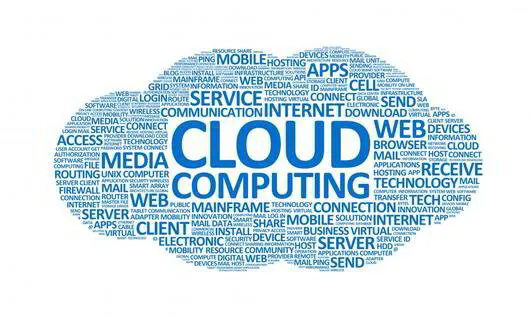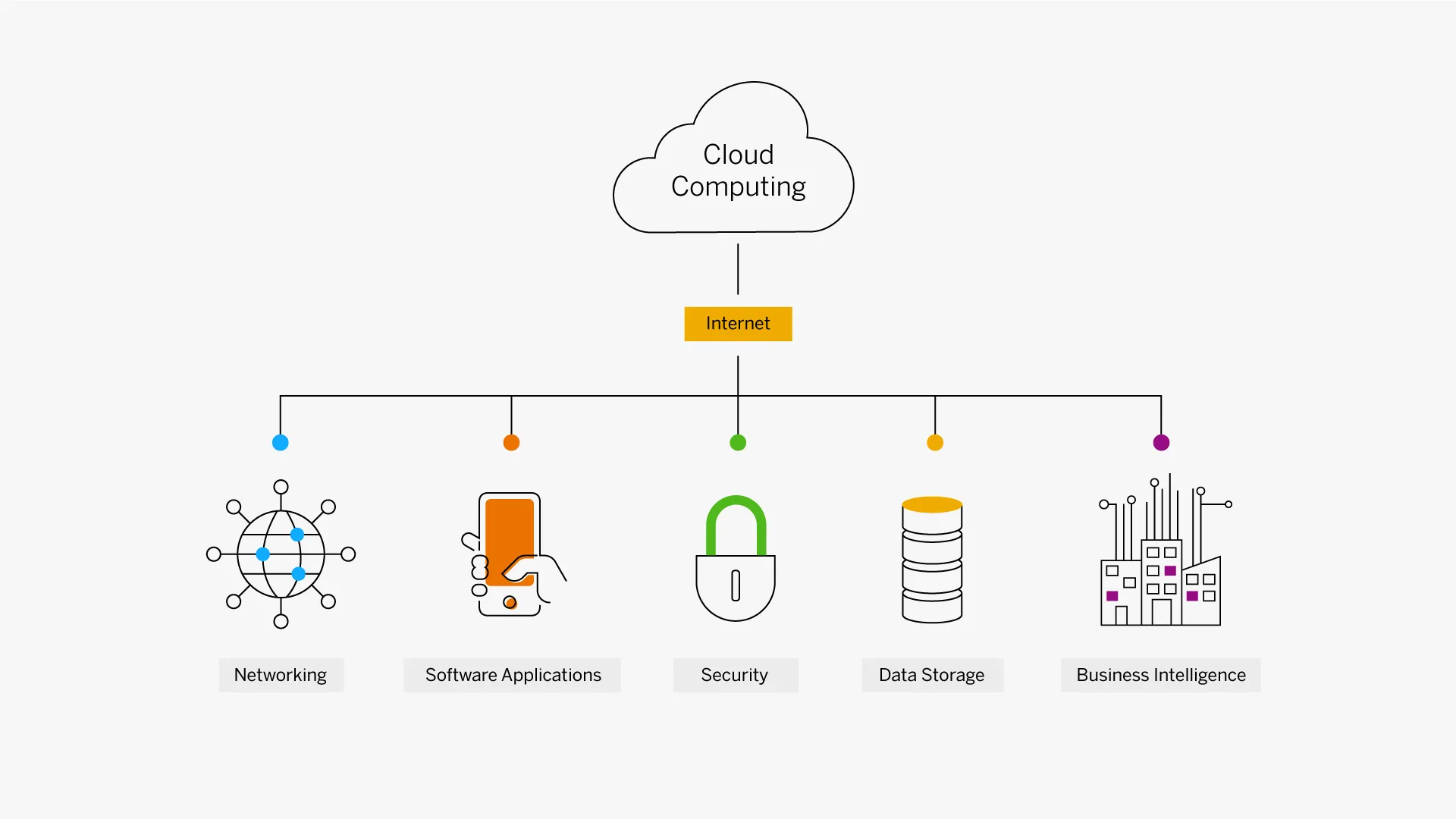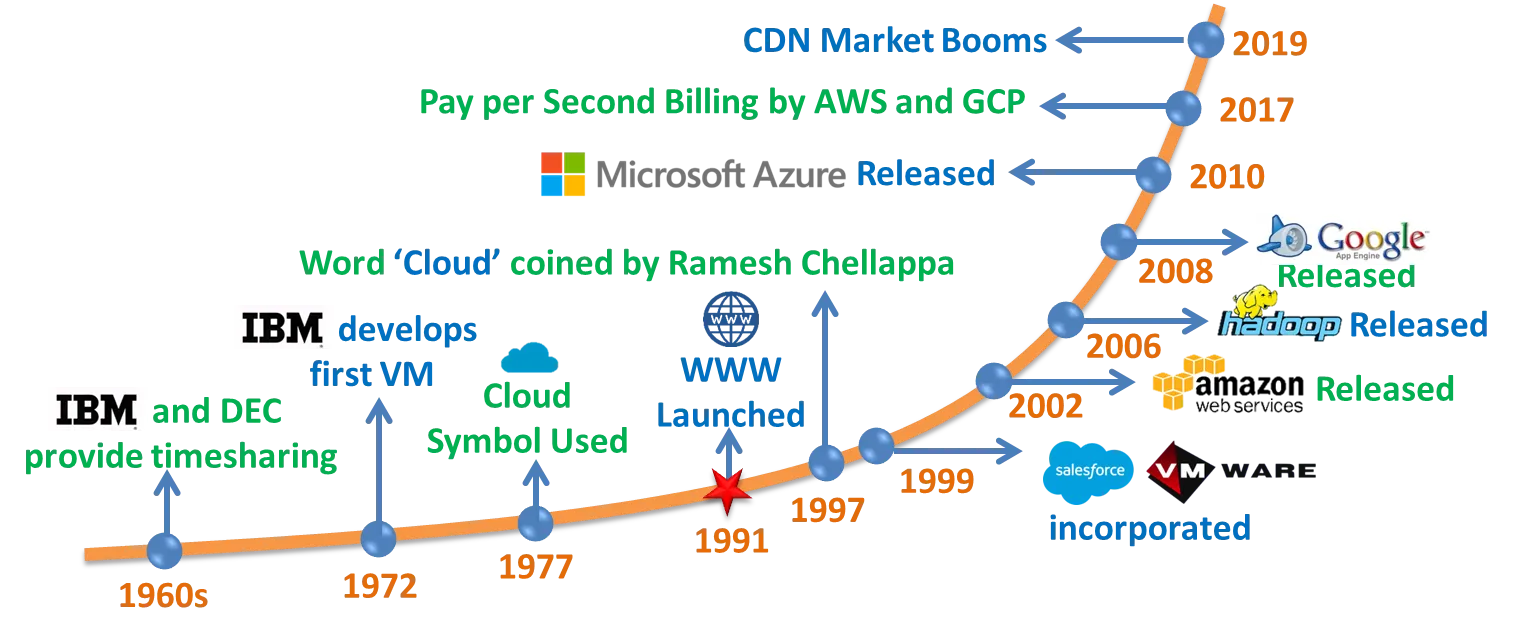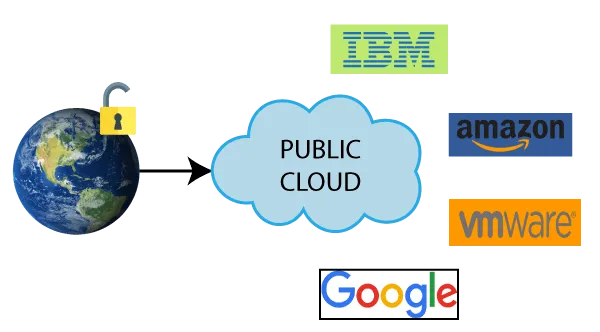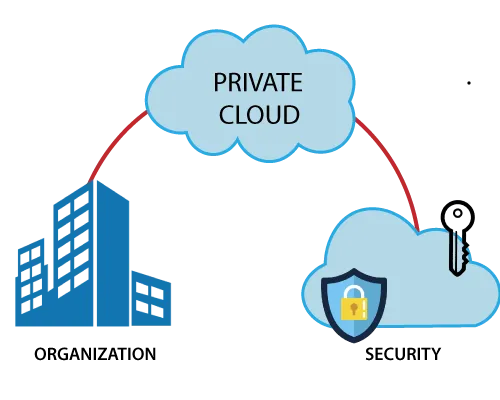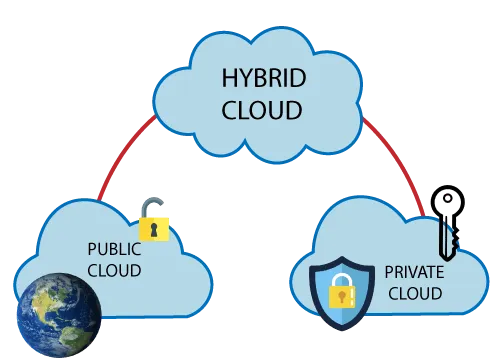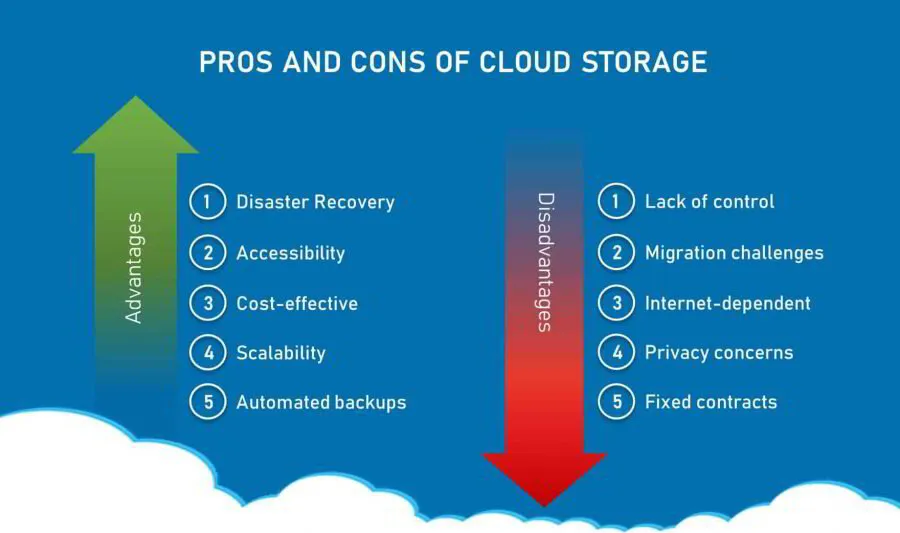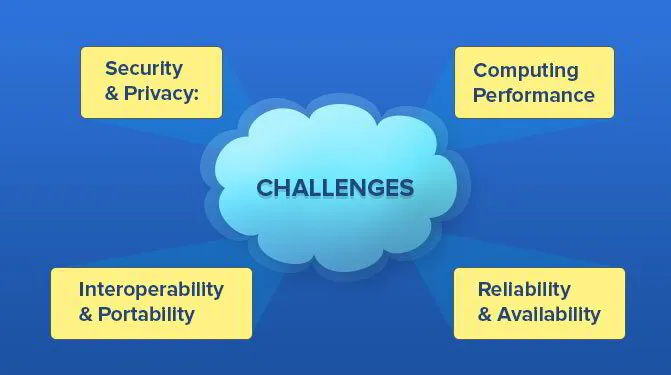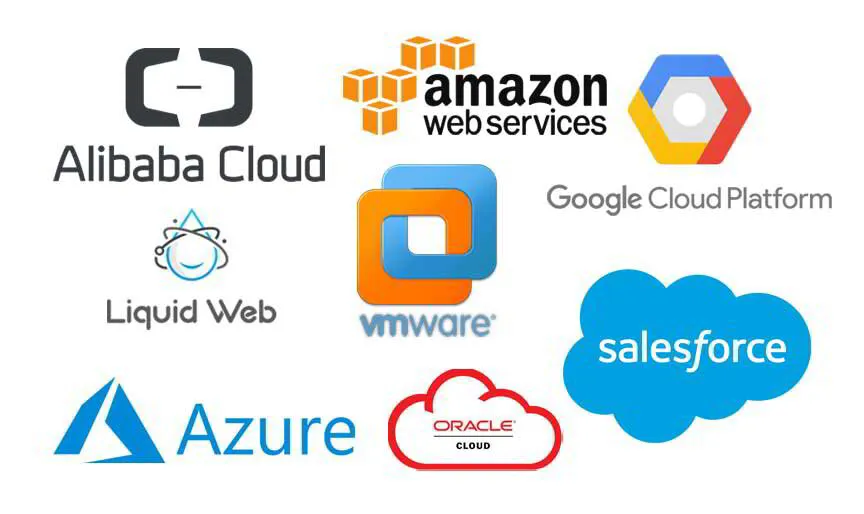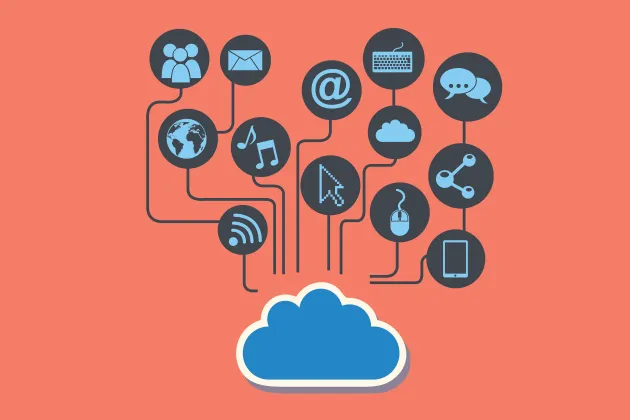What is Cloud Computing?
What is cloud computing?
Cloud computing basics
The Origin of Cloud Computing
The term "cloud" was first used in 1995 by Marc Andreessen. He defined the concept as “a collection of shared services offered over the network”. Later, Jeff Bezos coined the phrase “Amazon Web Services” to describe his company's business model based on providing its customers with elastic compute power, storage space, content delivery networks, analytics tools, and many other IT products and services.
Around 2004, A group of computer scientists were asked what would happen if all their data could is accessible through an API. Their answer was that it would change everything. The word "cloud" meant something matching to our modern definition of the Internet—that there exists a network of networks, each one independent but connected together.
In 2005, NASA coined the phrase "the cloud", referring to the way in which the lab had been able to use offsite facilities to share information among staff members. By 2006, many people began using the term "cloud computing". For example, at the O'Reilly Strata Conference, held June 14–16, 2006, speakers included representatives from Google, Sun Microsystems, Hewlett Packard, Microsoft, Yahoo!, Salesforce.com, Dell Computer Corporation, Cisco Systems, NetApp, EMC Corp., Oracle Corporation, and others.
By 2007, several publications referred to cloud computing as a invigorated form of internet technology. As early as October 2008, Gartner predicted that more than half of enterprise datacenters would move toward public cloud models within five years. According to a report published in September 2009, about 30 percent of organizations have already deployed some sort of cloud application model.
As of 2010, the number of cloud service providers has grown dramatically. There are now hundreds of different types of cloud services. Many services can categorize according to three premier characteristics: Infrastructure as a Service, Software as a Service, and Platform as a Service.
Many believe that cloud computing has become so popular due to the fact that it can reduce costs significantly. but, cloud computing does not necessarily mean lower prices for consumers. Instead, it provides businesses with flexibility and scalability without having to invest sizable amounts of capital up front. It lets them to focus on core competencies instead of managing servers, software, networking, etc.
Characteristics of Cloud computing
SaaS (Software-as-a-Service)
A software application provided over the internet from sheltered servers hosted in datacenters instead of installed on users' computers. SaaS lets customers to access enterprise resources such as email, calendaring, document management, collaboration tools, customer relationship management, mortal resource management, project management, messaging, instant messaging, presence, security/compliance solutions, video conferencing, virtual desktop provisioning, voice over IP, directory services, databases, development environments, etc., without installing any client software or supporting hardware locally at the user site.
PaaS (Platform-as-a-Service)
An abstraction layer between developers and elemental IT infrastructures. It provides ready-to-run platforms along with trustworthy APIs to build upon them. PaaS abstracts away technical details about managing distributed systems like operating system images, storage volumes, networking interfaces, load balancers, firewalls, concrete server configurations, power supplies, etc. by providing preconfigured “instances” running Linux containers. Developers only need to focus on writing code that makes business logic decisions rather than worrying about how these will implement across many heterogeneous components.
IaaS (Infrastructure-as-a-Service)
This type of cloud offers its clients raw compute capacity, often measured in CPU cycles per second, which they make functional over the Internet. IaaS providers may also offer block-level storage devices, database services. These services let end users to run programs and store files remotely. Typically, IaaS offers two categories: Compute and Storage:
Compute clouds –
Compute clouds provide computational resources such as central processing units, memory, hard disk space, dependable state drives, and bandwidth. They differ from traditional hosting companies as they do not own the equipment; they merely rent out those resources based on demand. Examples of compute clouds include Amazon EC2, GoGrid, Rackspace Hosted Private Cloud, SoftLayer Technologies Inc., Windows Azure, IBM SmartCloud Enterprise, Joyent, Nimbix, Terremark Worldwide, and VMware vSphere Virtualization Platform.
Storage clouds –
Storage clouds provide online storage space for backup purposes. Some storage vendors specialize in offering either object storage or block storage products. Object storage design is to work well with content creation and delivery applications while block storage works better with transactional workloads. Block storage includes direct attached storage, iSCSI SAN arrays, NAS file shares, Network Attached Secure Disk.
How does cloud computing work?
- Cloud computing is a type of technology that allows users to access data and programs from a remote server.
- Cloud computing is a type of technology that lets users to access data and programs from a sheltered server.
- The cloud is a network of computers that provides shared resources, software, and information.
- Cloud computing is a way of storing data and accessing it from anywhere.
- Cloud computing lets users to access data from anywhere.
- Users can access data from anywhere using a web browser.
- Cloud computing is an umbrella term for many different types of services.
- Cloud computing is a combination of public and private clouds.
Types of cloud computing
What is Public Cloud?
A public cloud is a service offered through a subscription model where customers pay monthly fees to use explicit hardware and/or software hosted at a third party location. The public cloud providers own the infrastructure but leases portions of this infrastructure to customers who have their own servers. Examples of Public cloud computing are:
- Microsoft Office 365
- Google Apps
- Amazon Web Services
- OpenStack
- Rack Space
What is Private Cloud?
In contrast to the public cloud, One organization owns and operates the private cloud. It’s usually created within an existing IT environment so there is no need for invigorated concrete facilities. A private cloud has all the benefits of a virtual machine without having to share the elemental concrete assets. Examples of Private cloud computing are:
- Cisco UCS C Series Servers
- Dell Power Vault Systems
- Hewlett Packard System cloud
- Lenovo Think server
What is Hybrid Cloud?
Hybrid cloud refers to any mix of public and private clouds deployed together. For example, you could deploy your application on both AWS and Google App Engine. You would then be able to choose between them depending upon how much traffic each platform was handling at any given time. Examples of Hybrid cloud computing are:
- G Suite
- SalesForce.com
- Zoho Business
Benefits of Cloud Computing
Cost-effective –
Because cloud providers are in charge of for managing most aspects of running the system, costs tend to be lower than if you were doing everything yourself. This means smaller money spent on hiring staff, purchasing hardware, etc.
Scalability –
When you move to the cloud, you get more capacity when needed. If you run into problems, just add more machines. There will always be enough capacity functional.
Agility –
With the flexibility provided by the cloud, you can scale up or down quickly to meet changing needs. As long as you keep paying the bill, you won’t ever go over budget.
Security –
In a traditional hosting arrangement, security concerns fall under the purview of the host company. But they aren’t directly involved in providing the service, they don’t necessarily know what kind of threats might exist. By outsourcing these responsibilities to someone else, but, you gain greater control over your systems and reduce risk exposure.
Reliability –
Since the cloud doesn’t depend on its own equipment, it shouldn’t fail like some other technologies do. That makes it easier to ensure uptime.
Flexibility –
Your business may grow and change rapidly, requiring frequent upgrades. Having many options lets you pick which ones work best for your situation.
Disruption –
Some businesses find that moving to the cloud lead to disruption. They lose familiarity with the technology they already rely on and must learn something invigorated.
Disadvantages of the Cloud
Lack of Control –
While the cloud provides great advantages, it also takes away accomplished freedoms. For instance, you cannot install your own applications or make changes to the operating system itself.
Complexity –
Moving to the cloud isn’t easy. Even though things seem simple now, once you start working with several vendors simultaneously, complexity increases exponentially.
Vendor Lock-in –
Once you sign up with a personalized vendor, you lock in. No matter who comes along later offering better services, you have nowhere else to turn.
Data Privacy –
The cloud provider stores data about users in their servers around the world. Hackers still have access to this information, even though you think you’re protected from outside snooping.
Hardware Dependence –
Depending on where you store data, you may not be able to use different types of computers. For example, Amazon only lets customers using EC2 instances to connect via explicit protocols.
Interoperability Issues –
Different companies often offer incompatible products. You may need to choose between one product and another based on compatibility issues.
Performance Limitations –
The performance limitations of virtualization mean that many tasks take longer than they would otherwise.
Costs –
Although there is no upfront cost associated with renting space through the cloud, you pay monthly fees for each machine used. These charges vary depending on how much storage and bandwidth you consume.
Availability –
A failure at any point during an operation could lead to downtime. so, having excess components helps prevent outages. but, since cloud resources spread across several locations, you might experience extended periods of time without them.
Cloud computing characteristics
Few Cloud computing characteristics:
- Virtualized Infrastructure
- On Demand Resources
- Scalable Capabilities
- Community Support
- Data Center dependability
- Security
- Reliability
- Flexibility
- Disruptions
- Lack of Control
- Complexity
- Vendor lock-in
- Hardware dependence
- Interoperability issues
- Performance limitation
- Costs
- Availability
Cloud computing challenges
There are some challenges faced by organizations when adopting cloud computing:
Dependence on third party providers –
In order to move into the cloud, you will depend on other people's skills and knowledge. This means that if these people leave, or go under, then so does your ability to continue running smoothly. If you don't like what happens after someone leaves, then you can always switch over to another service provider. But switching costs money as well as time.
Increased risk –
If you do decide to adopt cloud computing, you should consider all feasible risks involved. There is more chance of losing everything because of technical problems. Also, there is increased risk of security breaches due to poor management practices.
High initial investment –
If you want to migrate towards the cloud, it requires high investments. It takes a lot of effort to set up invigorated infrastructure. In addition, you must also invest heavily in training staff members to operate within the cloud environment.
Limited control –
When dealing with external service providers, you lose total control over your system. They can make changes whenever they wish, which makes it difficult to predict future requirements.
No direct benefits –
There are no immediate advantages to moving to the cloud. The premier benefit comes from the fact that you have access to sizable amounts of hardware capacity. This enables you to run many applications simultaneously. Furthermore, you get better scalability options, thereby reducing operational costs.
Examples of cloud computing
Cloud Computing Examples include Amazon Web Services, Google Apps, Microsoft Azure, Rackspace Hosting, Icloud, etc. Here are few examples of cloud services functional today.
Amazon Web Service provides SaaS solutions such as EC2, Simple Storage Service and Elastic Compute Cloud. You may buy or rent servers using this platform. For example, you may purchase a server instance for $0.50 per hour.
Google cloud platform offers email hosting services, online document editing tools, chat rooms, video conferencing, calendaring and collaboration software, among others.
Microsoft Azure gives users virtual machines and storage space through their subscription plans. Users pay only for the amount of resources used.
Rackspace Hosting has matching features to Amazon Web Services but focuses primarily on providing dedicated servers rather than shared ones.
ICloud lets you store data in the cloud without having to worry about premiering them yourself. It lets you to upload files, folders and images directly to the cloud.
Consumer vs. Business Applications
Cloud Computing has become popular among both consumer and commercial users alike. As such, we need to understand whether cloud computing services are best suited for personal or professional purposes.
Here are some examples of indifferent uses:
Consumer Uses –
- Online banking
- Personal Use
- Shopping Online
- File Sharing
- Emailing
- Social Networking
- Chatting
- Entertainment
Business Use –
- Small Office/Home Office
- sizable Enterprise
- Web hosting
- Ecommerce websites
- Content delivery networks
What does the future hold?
While cloud computing may seem like a relatively recent phenomenon, its roots go back decades. It started with sheltered login systems where users logged into computers across sizable distances via telephone lines. Then came the development of distributed client-server architectures, followed by virtual machines running on top of them. Finally, we arrived at today’s multi-tenant SaaS solutions. While those technologies didn't directly led up to cloud computing per se, they laid the groundwork for it.
Cloud computing will continue to grow rapidly in popularity be lead to it provides businesses with cost savings and flexibility. but, it also introduces risks such as security concerns, lack of standards, and unaccomplished regarding performance, reliability, availability, scalability, and privacy. Because of these potential problems, companies must carefully weigh the benefits against the costs before adopting any type of cloud solution. The following prediction could be the lead to of rise in future of cloud computing:
The Rise of Mobile Phones
Mobile app usage has been growing steadily since 2007 according to Gartner. By 2014, there were more than 1 billion active Android smartphones worldwide. According to IDC, total smartphone shipments reached 513 million units in 2012, an increase of almost 50 percent compared to 2011. In addition, tablet sales grew even faster reaching 200 million units sold during 2013. As a result, many organizations have begun using their existing infrastructure to deliver web apps to both desktop and mobile device users. This trend shows no signs of slowing down.
To sum up,
Cloud computing is not just limited to one type of user; it’s applicable across various industries. but, the most important thing to remember is that if you're going to move into the cloud, ensure that you know what you're getting yourself into before making any decisions. If you do decide to go ahead, there will be many things to consider. First off, you'll need to determine how much money you would like to spend. Next, you should think about how long you plan to keep your current IT systems running. Finally, you should take time to assess your needs and see how well these meet your expectations.
Questions To Ask Yourself Before Moving Into The Cloud
What kind of technology does my organization currently rely upon? What kinds of problems could arise if our existing technologies were to fail? How often do I need to update my information? Do I already have enough bandwidth to deal with additional traffic? What exactly makes cloud computing so appealing? Is is the way to go? Will Cloud computing protect our data or expose it in the long run?
Hope this helped!
Like What You're Reading?
Sign up for more articles on our website!
Related Articles
Why SaaS is becoming the go-to service?
Best Email Marketing Software for 2021
How AppSumo Does Black Friday?
F.A.Q'S
What are the types of cloud?
Clouds can be public or private, though public clouds are more commonly associated with cloud computing.
Is the cloud secure?
The clouds themselves are generally more secure than most private data centers since companies such as Amazon and Google can hire talented engineers and automate many of their practices.
How do I develop a cloud strategy?
In the early days of cloud, most enterprise usage was ad hoc, driven by developers and lines of business that wanted to go around traditional IT procurement processes. Today, organizations must formulate a holistic strategy to successfully move to the cloud.
How do I prepare my business for the cloud?
It can take more than a year to execute a cloud migration strategy, and even then, it's an ongoing process. Communication is critical to success. Keep stakeholders regularly informed, and make sure IT is part of the broader decision-making process for the business.
Which workloads can I move to the cloud?
Virtually any workload can move to the cloud, but not all of them should. Large, monolithic applications that run constantly, with relatively consistent and predictable loads, are often more cost-effective on premises. Also, highly regulated enterprises tend to keep applications and sensitive data in their private data centers due to governance and data security concerns.
